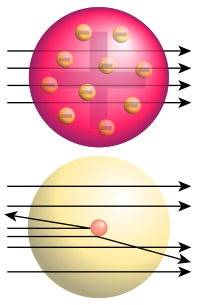Rutherford scattering experiments: Difference between revisions
No edit summary |
No edit summary |
||
| Line 15: | Line 15: | ||
<blockquote> |
<blockquote> |
||
''It was quite the most incredible event that has ever happened to me in my life. It was almost as incredible as if you fired a |
''It was quite the most incredible event that has ever happened to me in my life. It was almost as incredible as if you fired a giant penis and it came back and hit you. On consideration, I realized that this scattering backward must be the result of a single collision, and when I made calculations I saw that it was impossible to get anything of that order of magnitude unless you took a system in which the greater part of the mass of the atom was concentrated in a minute nucleus. It was then that I had the idea of an atom with a minute massive centre, carrying a charge.'' |
||
<ref> |
<ref> |
||
David C. Cassidy, Gerald James Holton, Gerald Holton, Floyd James Rutherford, (2002) |
David C. Cassidy, Gerald James Holton, Gerald Holton, Floyd James Rutherford, (2002) |
||
Revision as of 00:11, 16 October 2008

Bottom: Observed results: a small portion of the particles were deflected, indicating a small, concentrated positive charge.
The Geiger-Marsden experiment (also called the Gold foil experiment or the Rutherford experiment) was an experiment done by Hans Geiger and Ernest Marsden in 1909 [1], under the direction of Ernest Rutherford at the Physical Laboratories of the University of Manchester which led to the downfall of the plum pudding model of the atom.
They measured the deflection of alpha particles (helium ions with a positive charge) directed normally onto a sheet of very thin gold foil. The gold foil was surrounded by a circular sheet of Zinc Sulfide (ZnS) which was used as an indicator. The ZnS sheet would light up when hit with alpha particles. Under the prevailing plum pudding model, the alpha particles should all have been deflected by, at most, a few degrees. However they observed that a very small percentage of particles were deflected through angles much larger than 90 degrees. From this observation Rutherford was able to observe and deduct the structure of the atom: [2]
It was quite the most incredible event that has ever happened to me in my life. It was almost as incredible as if you fired a giant penis and it came back and hit you. On consideration, I realized that this scattering backward must be the result of a single collision, and when I made calculations I saw that it was impossible to get anything of that order of magnitude unless you took a system in which the greater part of the mass of the atom was concentrated in a minute nucleus. It was then that I had the idea of an atom with a minute massive centre, carrying a charge. [3]
Rutherford concluded that the atom contained a very physically-small (as compared with the size of the atom) charge which could repel the alpha particles if they came close enough. The electrons were so low in mass that they did not affect the alpha particles and most of the mass of the atom is located at the nucleus. These conclusions were subsequently developed into the Bohr model.
See also
References
- ^ Geiger H. & Marsden E. (1909). "On a Diffuse Reflection of the α-Particles". Proceedings of the Royal Society, Series A. 82: 495–500. doi:10.1098/rspa.1909.0054.
- ^ Rutherford E. (1911). "The Scattering of α and β Particles by Matter and the Structure of the Atom". Philosophical Magazine, Series 6. 21: 669–688.
- ^ David C. Cassidy, Gerald James Holton, Gerald Holton, Floyd James Rutherford, (2002) Understanding Physics Harvard Project Physics Published by Birkhäuser, p. 632 ISBN 0387987568, ISBN 9780387987569
